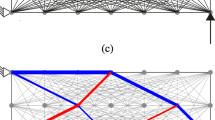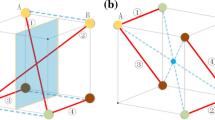Abstract
A tensegrity structure is a prestressed pin-jointed structure consisting of continuously connected tensile members (cables) and disjoint compressive members (struts). Many classical tensegrity structures are prestress stable, i.e., they are kinematically indeterminate but stabilized by introducing prestresses. This paper presents a procedure for generating various prestress stable tensegrity structures. This method is based on truss topology optimization and does not require connectivity relation of cables and struts of a tensegrity structure to be known in advance. Unlike the conventional form-finding methods, the locations of nodes are fixed throughout optimization. The optimization problem with the constraints expressing the definition of tensegrity structure, kinematical indeterminacy, and symmetry of configurations is formulated as a mixed integer linear programming (MILP) problem. Numerical experiments demonstrate that various tensegrity structures can be generated from one given initial structure by solving the presented MILP problems by using a few control parameters.












Similar content being viewed by others
Notes
A tensegrity structure with a few number of different member lengths was called a semiregular tensegrity structure by Zhang et al. (2006).
References
Bai Y, de Klerk E, Pasechnik D, Sotirov R (2009) Exploiting group symmetry in truss topology optimization. Optim Eng 10:331–349
Baudriller H, Maurin B, Cañadas P, Montcourrier P, Parmeggiani A, Bettache N (2006) Form-finding of complex tensegrity structures: application to cell cytoskeleton modelling. Comptes Rendus Mécanique 334:662–668
Bel Hadj Ali N, Rhode-Barbarigos L, Pascual Albi AA, Smith IFC (2010) Design optimization and dynamic analysis of a tensegrity-based footbridge. Eng Struct 32:3650–3659
Calladine CR (1978) Buckminster Fuller’s “tensegrity” structures and Clerk Maxwell’s rules for the construction of stiff frames. Int J Solids Struct 14:161–172
Connelly R, Back A (1998) Mathematics and tensegrity. American Scientist 86:142–151
Connelly R, Fowler PW, Guest SD, Schulze B, Whiteley WJ (2009) When is a symmetric pin-jointed framework isostatic? Int J Solids Struct 46:762–773
Connelly R, Terrell M (1995) Globally rigid symmetric tensegrities. Structural Topology 21:59–77
Connelly R, Whiteley W (1996) Second-order rigidity and prestress stability for tensegrity frameworks. SIAM J Discrete Math 6:453–491
Ehara S, Kanno Y (2010) Topology design of tensegrity structures via mixed integer programming. Int J Solids Struct 47:571–579
Fowler PW, Guest SD (2000) A symmetry extension of Maxwell’s rule for rigidity of frames. Int J Solids Struct 37:1793–1804
Guest SD (2006) The stiffness of prestressed frameworks: a unifying approach. Int J Solids Struct 43:842–854
Guo X, Ni C, Cheng G, Du Z (2012) Some symmetry results for optimal solutions in structural optimization. Struct Multidisc Optim 46:631–645
Gurobi Optimization Inc. (2010) Gurobi Optimizer Reference Manual. http://www.gurobi.com/
Hanaor A (1988) Prestressed pin-jointed structures—flexibility analysis and prestress design. Comput Struct 28:757–769
Hanaor A, Liao M-K (1991) Double-layer tensegrity grids: static load response. Part I: analytical study. J Struct Eng (ASCE) 117:1660–1674
Heartney E (2009) Kenneth Snelson: forces made visible. Hard Press Editions, Lenox
IBM ILOG (2010) User’s manual for CPLEX. http://www.ilog.com/
Juan SH, Mirats Tur JM (2008) Tensegrity frameworks: static analysis review. Mech Mach Theory 43:859–881
Kanno Y (2012) Topology optimization of tensegrity structures under self-weight loads. J Oper Res Soc Jpn 55:125–145
Kanno Y (2013) Topology optimization of tensegrity structures under compliance constraint: a mixed integer linear programming approach. Optim Eng. doi:10.1007/s11081-011-9172-0
Kanno Y, Guo X (2010) A mixed integer programming for robust truss topology optimization with stress constraints. Int J Numer Methods Eng 83:1675–1699
Kanno Y, Ohsaki M, Murota K, Katoh N (2001) Group symmetry in interior-point methods for semidefinite program. Optim Eng 2:293–320
Li Y, Feng X-Q, Cao Y-P, Gao H (2010a) A Monte Carlo form-finding method for large scale regular and irregular tensegrity structures. Int J Solids Struct 47:1888–1898
Li Y, Feng X-Q, Cao Y-P, Gao H (2010b) Constructing tensegrity structures from one-bar elementary cells. Proc R Soc Lond A Math Phys Sci 466:45–61
Masic M, Skelton RE, Gill PE (2005) Algebraic tensegrity form-finding. Int J Solids Struct 42:4833–4858
Micheletti A (2012) Modular tensegrity structures: the TorVergata footbridge. In: Frémond M, Maceri F (eds) Mechanics, models and methods in civil engineering. Springer-Verlag, Berlin, pp 375–384
Micheletti A, Williams WO (2007) A marching procedure for form-finding for tensegrity structures. J Mech Mater Struct 2:857–882
Motro R (2003) Tensegrity. Kogan Page Science, London
Pellegrino S (1992) A class of tensegrity domes. Int J Space Struct 7:127–142
Pellegrino S, Calladine CR (1986) Matrix analysis of statically and kinematically indeterminate frameworks. Int J Solids Struc 22:409–428
Rasmussen MH, Stolpe M (2008) Global optimization of discrete truss topology design problems using a parallel cut-and-branch method. Comput Struct 86:1527–1538
Rieffel J, Valero-Cuevasa F, Lipson H (2009) Automated discovery and optimization of large irregular tensegrity structures. Comput Struct 87:368–379
Ross E, Schulze B, Whiteley W (2011) Finite motions from periodic frameworks with added symmetry. Int J Solids Struct 48:1711–1729
Rozvany GIN (2011) On symmetry and non-uniqueness in exact topology optimization. Struct Multidisc Optim 43:297–317
Schulze B, Whiteley W (2011) The orbit rigidity matrix of a symmetric framework. Discrete Comput Geom 46:561–598
Skelton R, de Oliveira MC (2009) Tensegrity systems. Springer, Dordrecht
Stolpe M (2010) On some fundamental properties of structural topology optimization problems. Struct Multidisc Optim 41:661–670
Stolpe M, Svanberg K (2003) Modelling topology optimization problems as linear mixed 0–1 programs. Int J Numer Methods Eng 57:723–739
Tibert AG, Pellegrino S (2003) Review of form-finding methods for tensegrity structures. Int J Space Struct 18:209–223
Tran HC, Lee J (2011) Determination of a unique configuration of free-form tensegrity structures. Acta Mech 220:331–348
Watada R, Ohsaki M, Kanno Y (2011) Non-uniqueness and symmetry of optimal topology of a shell for minimum compliance. Struct Multidisc Optim 43:459–471
Xu X, Luo Y (2010) Form-finding of nonregular tensegrities using a genetic algorithm. Mech Res Commun 37:85–91
Zhang JY, Guest SD, Ohsaki M (2009) Symmetric prismatic tensegrity structures. Part II: symmetry-adapted formulations. Int J Solids Struct 46:15–30
Zhang JY, Ohsaki M (2007) Stability conditions for tensegrity structures. Int J Solids Struct 44:3875–3886
Zhang L, Maurin B, Motro R (2006) Form-finding of nonregular tensegrity systems. J Struct Eng (ASCE) 132:1435–1440
Acknowledgments
The author would like to thank the anonymous reviewers for their constructive comments. This work is partially supported by Grant-in-Aid for Scientific Research (C) 23560663, by the Global COE Program “The Research and Training Center for New Development in Mathematics,” and by the Aihara Project, the FIRST program from JSPS, initiated by CSTP.
Author information
Authors and Affiliations
Corresponding author
Appendix: MILP formulation
Appendix: MILP formulation
In Section 5, we have formulated the optimization problem for design of tensegrity structures, problem (26), and shown that this optimization problem can be reformulated as an MILP problem. This MILP problem has been solved in Section 6 by using a commercial MILP solver. The explicit description of this MILP problem is given as
Note that constraint (27p) is a valid inequality constraint, because constraints (27c), (27d) and (27n) imply (27p).
Rights and permissions
About this article
Cite this article
Kanno, Y. Exploring new tensegrity structures via mixed integer programming. Struct Multidisc Optim 48, 95–114 (2013). https://doi.org/10.1007/s00158-012-0881-6
Received:
Revised:
Accepted:
Published:
Issue Date:
DOI: https://doi.org/10.1007/s00158-012-0881-6




